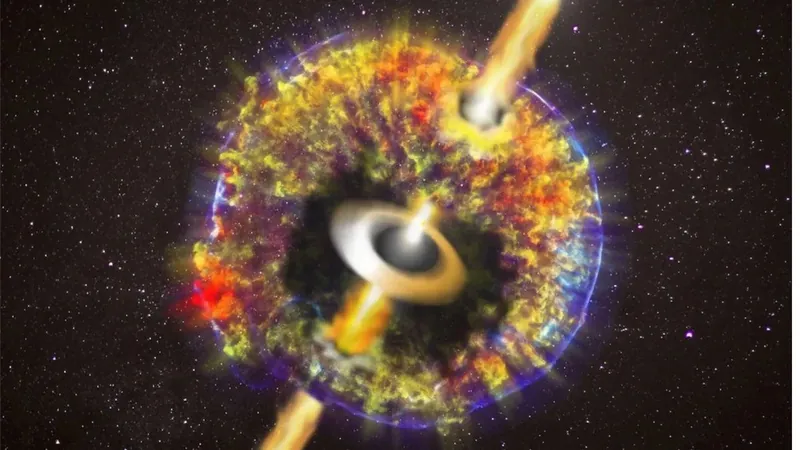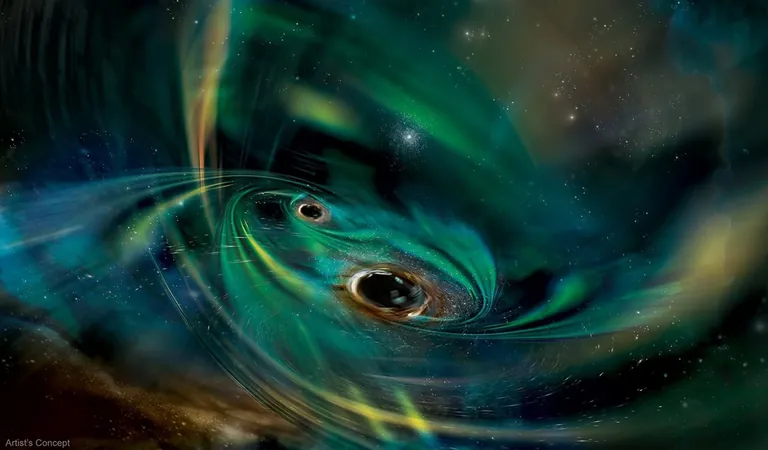
Hubble Captures Spectacular Collision of Neutron Stars, Creating a Black Hole and Forging Gold in Cosmic Fireworks!
2024-11-08
Author: Jacob
The Exciting Discovery of Neutron Star Collision
Astronomers are buzzing with excitement after witnessing a monumental collision of neutron stars, resulting in the birth of the smallest black hole yet observed and the creation of precious metals including gold, silver, and uranium. This groundbreaking event occurred a staggering 130 million light-years away in the galaxy NGC 4993 and was captured using an array of sophisticated instruments, prominently featuring the Hubble Space Telescope.
The Kilonova
This titanic merger, which scientists refer to as a "kilonova," sent out a brilliant burst of light that was approximately 100 times brighter than our sun, igniting the cosmic stage with a display as dazzling as hundreds of millions of suns combined. As researchers aim to unravel the mysteries behind these kilonovas, they hope to shed light on the origins of elements heavier than iron, which cannot be forged in the hearts of even the most massive stars.
Real-Time Observations
Team member Rasmus Damgaard from the Cosmic DAWN Center expressed the thrill of this discovery, stating, “For the first time, we see atomic nuclei and electrons forming in real-time during the aftermath of a neutron star collision. We are essentially peering into the birthplace of atoms themselves.” The team's investigation not only captures the events of this explosive merger but also the surprisingly intricate dance of particles that creates the foundation of our universe.
Formation of Neutron Stars
Neutron stars form when massive stars exhaust their nuclear fuel, collapsing under their gravity and forming extremely dense remnants roughly 12 miles (20 kilometers) across. These remnants are so dense that just a sugar cube's worth of neutron star material would weigh about 1 billion tons – a mass comparable to squeezing 150 million elephants into a cubic sugar cube!
Binary Systems and Gravitational Waves
Interestingly, neutron stars often exist in binary systems, orbiting a companion star. If conditions are just right, both stars can evolve into neutron stars, leading to dangerous cosmic encounters. As they draw closer, the two neutron stars generate gravitational waves, rippling through space-time as they spiral inwards until they inevitably collide.
Extreme Conditions During Collision
In this collision, temperatures soar to billions of degrees—hotter than the surface of the sun and comparable to the conditions of the universe just after the Big Bang. As these neutron stars merge, they eject neutron-rich matter at breakneck speeds, giving birth to black hole remnants shrouded in cooling plasma.
Synthesis of Heavy Elements
Through these violent events, heavy elements like Strontium and Yttrium are synthesized via the rapid neutron capture process (r-process), alongside lighter yet still hefty metals such as gold, silver, and uranium. The rapid expansion and cooling of the ejected material provide a glimpse into the complex physics of neutron star mergers.
Insights from Observations
"Observing this kilonova allows us to see the explosion evolve over time from afar, giving us insights into its history," explained team member Kasper Heintz, noting the fascinating intricacies of the explosion as light travels through the expanding matter.
International Collaboration
Achieving this landmark understanding required international collaboration, with telescopes spanning different continents and the cosmos working in concert. "This astrophysical event unfolds quickly, hour by hour, meaning no single telescope could capture the full narrative alone," affirmed team leader Albert Sneppen. "By piecing together observations from locations such as Australia, South Africa, and utilizing Hubble, we can create a comprehensive timeline of events."
Publication and Future Exploration
The findings were formally published in the esteemed journal *Astronomy & Astrophysics* on October 30, 2023, setting the stage for further exploration into the mysteries of the universe. This remarkable discovery highlights not only the monumental energy released during such cosmic events but also reinforces our understanding of the origins of elements that make up the very fabric of our existence. Who knew your jewelry could be a product of colossal celestial collisions? The universe truly has a way of turning chaos into beauty!









 Brasil (PT)
Brasil (PT)
 Canada (EN)
Canada (EN)
 Chile (ES)
Chile (ES)
 España (ES)
España (ES)
 France (FR)
France (FR)
 Hong Kong (EN)
Hong Kong (EN)
 Italia (IT)
Italia (IT)
 日本 (JA)
日本 (JA)
 Magyarország (HU)
Magyarország (HU)
 Norge (NO)
Norge (NO)
 Polska (PL)
Polska (PL)
 Schweiz (DE)
Schweiz (DE)
 Singapore (EN)
Singapore (EN)
 Sverige (SV)
Sverige (SV)
 Suomi (FI)
Suomi (FI)
 Türkiye (TR)
Türkiye (TR)